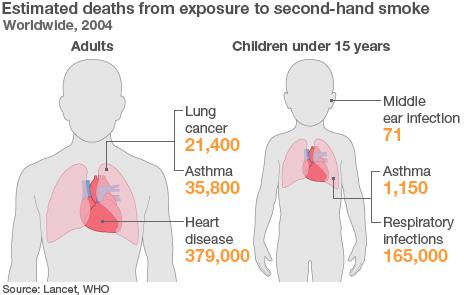Passive smoking 'kills 600,000' worldwide
- Published

Children are particularly at risk of the effects of passive smoking in their own homes
The first global study into the effects of passive smoking has estimated it causes 600,000 deaths every year.
One-third of those killed are children, often exposed to smoke at home, the World Health Organization (WHO) suggested.
The November 2010 study, external, in 192 countries, concluded passive smoking is particularly dangerous for children, who are said to be at higher risk of sudden infant death syndrome, pneumonia and asthma.
Passive smoking has been linked to heart disease, respiratory illness and lung cancer.
"This helps us understand the real toll of tobacco," said Armando Peruga, of the WHO's Tobacco-Free Initiative, who led the study.
'Deadly combination'
It used estimates of the incidence of specific diseases and of the number of people exposed to second-hand smoke in particular areas.
The global health body said it was particularly concerned about the estimated 165,000 children who die of smoke-related respiratory infections, mostly in South East Asia and in Africa.

It said that this group was more exposed to passive smoking than any other group, principally in their own homes.
"The mix of infectious diseases and second-hand smoke is a deadly combination," Mr Peruga said.
As well as being at increased risk of a series of respiratory conditions, the lungs of children who breathe in passive smoke may also develop more slowly than children who grow up in smoke-free homes.
Worldwide, as many as 40% of children, 33% of non-smoking men and 35% non-smoking women were exposed to second-hand smoke in 2004, researchers found.
This exposure was estimated to have caused 379,000 deaths from heart disease, 165,000 from lower respiratory infections, 36,900 from asthma and 21,400 from lung cancer.
According to the study, the highest numbers of people exposed to second-hand smoke are in Europe and Asia and the lowest rates of exposure were in the Americas, the Eastern Mediterranean and Africa.
The research also revealed that passive smoking had a large impact on women, killing about 281,000 worldwide. This is due to the fact that in many parts of the world, the study suggests, women are at least 50% more likely to be exposed to second-hand smoke than men.
However, the researchers said were limitations to the study, including uncertainties about the underlying health data and gaps in the data relating to exposure to second-hand smoke.
Writing in the Lancet, Dr Heather Wipfli of the University of Southern California and colleagues, said: "There are well acknowledged uncertainties in estimates of disease burden.
"However, there can be no question that the 1.2bn smokers in the world are exposing billions of non-smokers to second-hand smoke, a disease-causing indoor air pollutant."
- Published16 November 2010